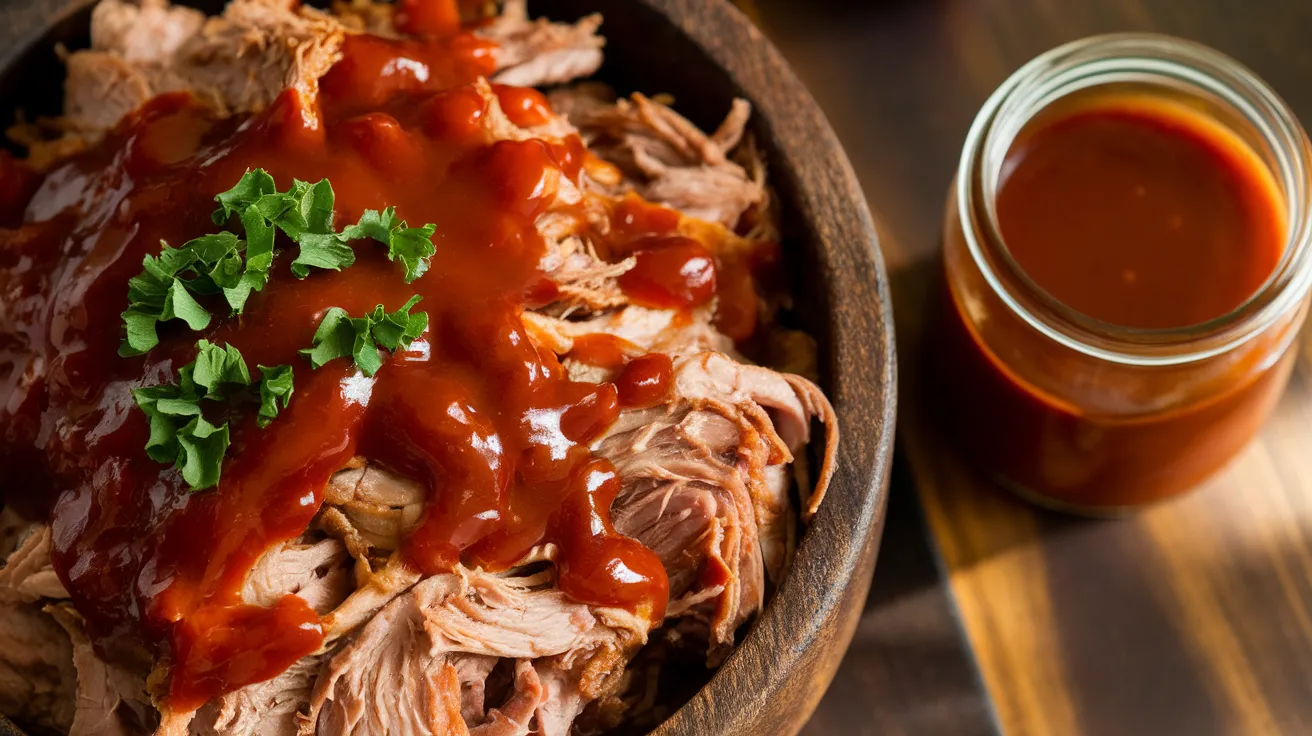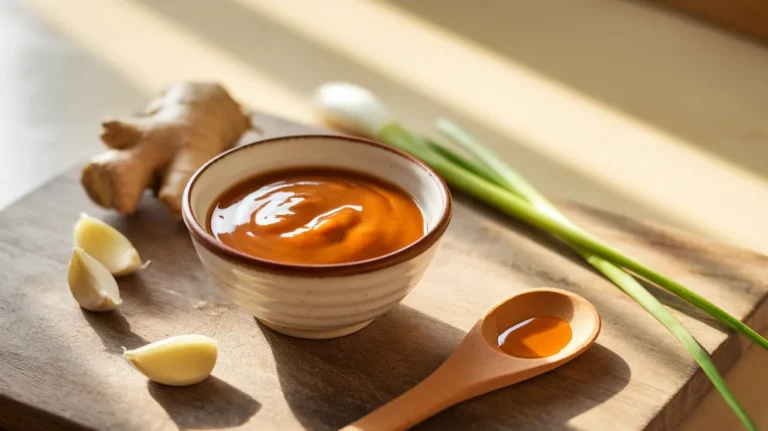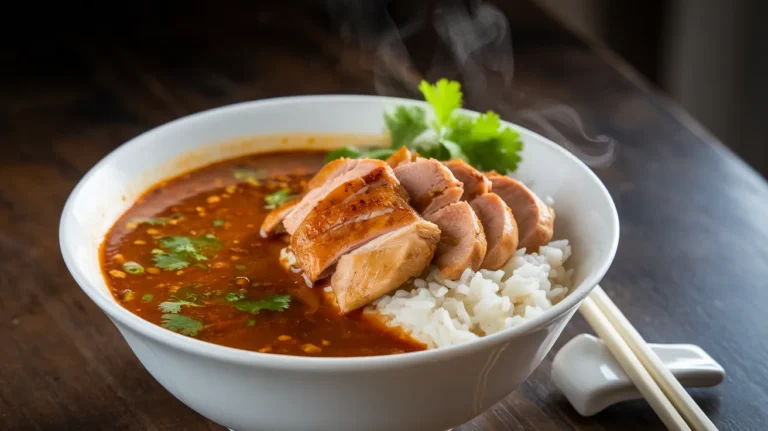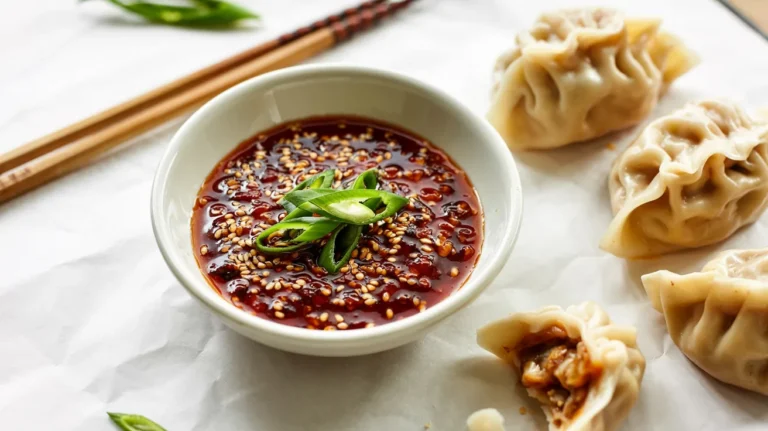This ultimate sauce for pulled pork recipe creates the perfect balance of sweet, tangy, and smoky flavors that transform ordinary shredded meat into restaurant-quality barbecue. Our foolproof sauce for pulled pork method ensures beginners achieve professional results every single time.
SERVES: 4 | PREP: 20 MIN | COOK: 25 MIN | TOTAL: 45 MIN
Ingredients for the Best Sauce for Pulled Pork
Base Sauce Components
| Ingredient | Amount | Notes |
|---|---|---|
| Ketchup | 1 cup | Use thick variety like Heinz |
| Apple cider vinegar | ¼ cup | Creates perfect tang balance |
| Brown sugar | 3 tablespoons | Pack firmly when measuring |
| Molasses | 2 tablespoons | Dark variety preferred |
| Worcestershire sauce | 2 tablespoons | Essential umami depth |
Spice Blend
| Spice | Amount | Purpose |
|---|---|---|
| Smoked paprika | 1 tablespoon | Smoky backbone flavor |
| Garlic powder | 2 teaspoons | Aromatic foundation |
| Onion powder | 1 teaspoon | Sweet depth |
| Dry mustard | 1 teaspoon | Sharp bite |
| Black pepper | ½ teaspoon | Freshly ground |
| Cayenne pepper | ¼ teaspoon | Heat level control |
Finishing Touches
- Butter – 2 tablespoons (adds richness)
- Liquid smoke – ½ teaspoon (optional authenticity)
Step-by-Step Instructions for Homemade Sauce for Pulled Pork
Phase 1: Preparation and Setup (8 minutes)
Step 1: Organize Your Workspace Clear your kitchen counter and place all ingredients within arm’s reach. Get out measuring cups, spoons, a medium saucepan, and a whisk. This preparation step prevents scrambling for ingredients while cooking, which can lead to burnt or uneven sauce.
Step 2: Measure All Ingredients Precisely Use dry measuring cups for sugar and spices, liquid measuring cups for vinegar and sauces. Level off dry ingredients with a knife for accuracy. Place each measured ingredient in separate small bowls – this technique called “mise en place” ensures you don’t accidentally double-add anything.
Step 3: Prepare Your Cooking Surface Set your stovetop to medium-low heat and place your saucepan on the burner. Don’t turn the heat on yet – we want gradual temperature increase to prevent scorching. Have a wooden spoon or whisk ready for stirring.
Phase 2: Building the Sauce Base (10 minutes)
Step 4: Start with the Ketchup Foundation Turn heat to medium-low and add the full cup of ketchup to your cold pan. Stir immediately with your whisk to prevent sticking. The ketchup will start to bubble gently around the edges after 2-3 minutes. If it bubbles vigorously, reduce heat immediately – high heat will scorch the sugars and create bitter flavors.
Step 5: Add Vinegar Slowly Pour the apple cider vinegar in a thin, steady stream while whisking constantly. The mixture will thin out and may splatter slightly – this is normal. The vinegar’s acidity will brighten the ketchup’s color from deep red to lighter burgundy. Continue stirring for 1 full minute to incorporate completely.
Step 6: Dissolve the Sugars Add brown sugar first, whisking until completely dissolved with no gritty texture remaining. This takes about 2 minutes of constant stirring. Next, add molasses slowly while whisking – it’s thick, so pour carefully to avoid globs. The sauce will darken to rich mahogany color and become slightly thicker.
Step 7: Incorporate Worcestershire Pour in Worcestershire sauce all at once and whisk thoroughly. This adds deep, savory umami flavor that balances the sweetness. The sauce should be smooth and glossy at this point, with no streaks or separation.
Phase 3: Adding Spices and Flavor Development (12 minutes)
Step 8: Prepare the Spice Mixture In a small bowl, combine all dry spices: smoked paprika, garlic powder, onion powder, dry mustard, black pepper, and cayenne. Whisk them together first – this prevents clumping when added to the wet sauce and ensures even distribution throughout.
Step 9: Add Spices Gradually Sprinkle the spice mixture over the sauce surface, then immediately whisk to incorporate. Add spices in three additions, whisking thoroughly after each. This prevents lumps from forming. The sauce will darken further and develop a rich, complex aroma.
Step 10: Begin the Simmering Process Reduce heat to low – you want gentle bubbles that barely break the surface, not a rolling boil. A proper simmer looks like tiny bubbles occasionally rising to the top. Too much heat will cause the sauce to reduce too quickly and concentrate flavors unevenly.
Step 11: First Simmering Phase Let the sauce simmer for 8 minutes, stirring every 2 minutes with a wooden spoon or whisk. Scrape the bottom of the pan each time to prevent sticking. The sauce will reduce by about one-fourth and become noticeably thicker. You’ll notice the flavors becoming more concentrated and aromatic.
Phase 4: Testing and Adjusting Your Sauce for Pulled Pork (10 minutes)
Step 12: Check Consistency Dip your spoon into the sauce and lift it up. The sauce should coat the back of the spoon and drip off slowly in a steady stream, not run off immediately. If it’s too thin, continue simmering 3-4 more minutes. If too thick, add 1 tablespoon of warm water.
Step 13: Taste and Balance Flavors Remove the pan from heat temporarily and taste with a clean spoon. The sauce should have balanced sweet, tangy, and smoky notes. If too sweet, add 1 teaspoon vinegar. If too tangy, add 1 teaspoon brown sugar. If lacking depth, add ¼ teaspoon more Worcestershire. Always taste after each adjustment.
Step 14: Final Simmering Return to low heat for final 5-7 minutes of simmering. This final phase allows adjusted flavors to meld together. Continue stirring every 2 minutes to prevent bottom scorching. The sauce will develop a glossy, rich appearance.
Phase 5: Finishing Touches (5 minutes)
Step 15: Add Butter for Richness Remove the saucepan from heat completely. Add cold butter one tablespoon at a time, whisking constantly until each piece melts completely before adding the next. This technique creates a glossy, restaurant-quality finish and adds richness that balances the acidity.
Step 16: Optional Liquid Smoke If using liquid smoke, add it drop by drop, tasting after each addition. Start with just 3-4 drops – liquid smoke is incredibly potent and can overpower the sauce quickly. You want subtle smokiness, not an artificial taste.
Step 17: Final Strain (Optional) For perfectly smooth sauce, pour through a fine-mesh strainer into a clean bowl, pressing solids with the back of a spoon. For rustic texture that many prefer with pulled pork, skip this step.
Step 18: Cool and Thicken Let the sauce cool for 10 minutes before using. It will thicken considerably as it cools to the perfect consistency for coating pulled pork. If it becomes too thick, whisk in warm water one teaspoon at a time.
Chef’s Notes for Perfect Sauce for Pulled Pork
Temperature Control: Low and slow cooking prevents bitter, burnt flavors. If your sauce starts smoking or develops dark spots, it’s too hot. Remove from heat, stir vigorously, and reduce temperature.
Spice Integration: Toast smoked paprika in a dry pan for 30 seconds before adding to intensify smoky flavors. This extra step elevates the sauce from good to exceptional.
Consistency Secrets: The sauce for pulled pork should coat meat without being gloppy. Test by mixing a spoonful with shredded meat – it should cling nicely without pooling at the bottom.
Make-Ahead Benefits: This sauce for pulled pork actually improves after sitting overnight as flavors meld and develop complexity. Store covered in refrigerator and reheat gently before using.
Nutrition Information (Per Serving)
- Calories: 85
- Protein: 1g
- Carbohydrates: 18g
- Fat: 6g
- Sodium: 285mg
- Sugar: 15g
Creative Variations of Sauce for Pulled Pork
Carolina Gold Style: Replace half the ketchup with yellow mustard and add 1 tablespoon honey for tangy variation. This technique also works beautifully with our sauce for kielbasa recipe.
Kansas City Thick: Double the molasses and add 2 tablespoons tomato paste for restaurant-style thickness that heavily coats meat.
Memphis Dry Rub Hybrid: Reduce liquid ingredients by half and add 2 tablespoons chili powder for sauce-rub combination.
Bourbon BBQ: Add 3 tablespoons bourbon whiskey during simmering phase for sophisticated depth. Similar enhancement technique works for our sauce for beef tenderloin preparation.
Storage & Reheating Your Pulled Pork Sauce
Refrigerator Storage: Keep sealed in glass jar up to 2 weeks. Sauce thickens when cold – this is completely normal behavior.
Freezer Method: Freeze in ice cube trays for 3 months. Each cube equals roughly 2 tablespoons for easy portioning when making smaller batches.
Reheating Tips: Warm gently over low heat, whisking in 1-2 tablespoons water if needed to restore original consistency.
Food Safety: Always reheat to 165°F internal temperature when using on previously cooked meat to ensure safety.
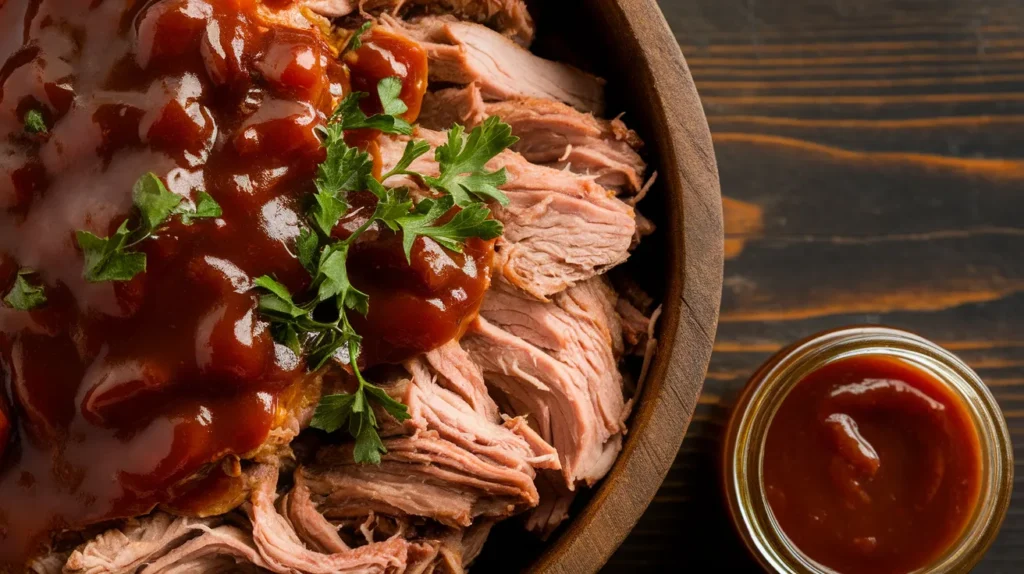
Troubleshooting Your Sauce for Pulled Pork
Problem: Sauce Too Sweet Add 1 tablespoon apple cider vinegar at a time until balanced. Taste between additions and allow flavors to meld for 1 minute before deciding if more is needed.
Problem: Too Tangy or Sharp Whisk in 1 tablespoon brown sugar or 1 teaspoon honey to mellow excessive acidity. Brown sugar integrates more smoothly than granulated sugar.
Problem: Sauce Separated or Broken Remove from heat immediately, cool slightly, then whisk in 1 tablespoon cold butter to re-emulsify. This usually fixes separation issues.
Problem: Too Thin Consistency Return to heat and simmer uncovered 5-10 additional minutes until desired thickness reached. Stir frequently to prevent scorching during reduction.
Problem: Burnt or Scorched Bottom Taste Transfer to clean pan immediately without scraping bottom. Add 1 teaspoon brown sugar to mask any bitter notes that developed.
Equipment Essentials
- Medium saucepan (2-3 quart capacity)
- Wire whisk (prevents lumping better than spoon)
- Measuring cups and spoons
- Fine-mesh strainer (optional for smooth texture)
- Glass storage jars (non-reactive material)
- Wooden spoon (backup for whisking)
Shopping List for Sauce for Pulled Pork
Condiment Aisle
- Ketchup (32 oz bottle)
- Apple cider vinegar
- Worcestershire sauce
- Liquid smoke (optional)
Baking Aisle
- Brown sugar
- Molasses
- Smoked paprika
- Garlic powder
- Onion powder
- Dry mustard powder
Dairy Section
- Butter (unsalted preferred)
Success Secrets for Perfect Sauce for Pulled Pork
1. Always simmer sauce completely before adding to pulled pork. Raw sauce ingredients taste harsh and unbalanced compared to properly cooked versions.
2. Reserve ¼ cup sauce separately before mixing with meat. Use this clean sauce for serving alongside finished dish or for guests who want extra.
3. Add sauce to warm pulled pork gradually, starting with half amount. Meat continues absorbing flavors as it sits, so you can always add more.
4. For competition-quality results, apply thin sauce layer, let rest 10 minutes, then add remaining sauce for optimal flavor penetration into meat fibers.
5. This versatile sauce for pulled pork works equally well as marinade, basting sauce during cooking, or finishing sauce – ultimate flexibility in one recipe.
This homemade sauce for pulled pork recipe transforms any barbecue meal from ordinary to extraordinary. The perfectly balanced sweet-tangy-smoky profile complements tender meat while adding restaurant-quality depth that keeps guests coming back for more. Master this fundamental sauce for pulled pork technique, and you’ll have the foundation for countless barbecue variations.
